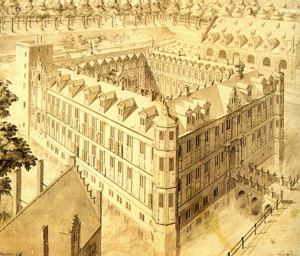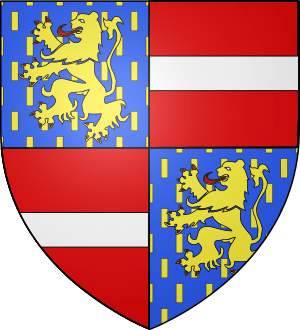Henry III of Nassau-Breda facts for kids
Quick facts for kids
Henry III of Nassau-Dillenburg-Dietz
|
|
|---|---|
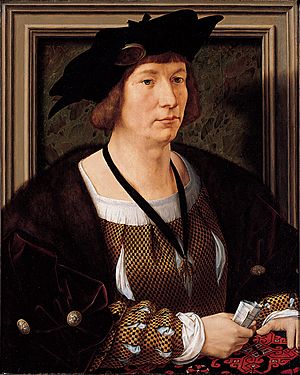
Henry III by Jan Gossaert
|
|
| Born | 12 January 1483 Siegen, County of Nassau |
| Died | 14 September 1538 (aged 55) Breda, Duchy of Brabant |
| Allegiance | Habsburg dynasty |
| Rank | Captain General |
| Battles/wars | War of the League of Cambrai Italian War of 1521 |
Henry III of Nassau-Dillenburg-Dietz was an important count from the House of Nassau. He was born on January 12, 1483, in Siegen and passed away on September 14, 1538, in Breda. He was also known as the Lord of Breda and Dietz.
Henry was the son of Count John V of Nassau-Dillenburg and Elisabeth of Hesse-Marburg. His younger brother, William I, Count of Nassau-Siegen, later became the father of the famous William the Silent.
Contents
Henry III's Important Career
In 1499, Henry's uncle, Count Engelbert II, invited him to the Burgundian Netherlands. Henry was chosen as his uncle's heir. He even traveled with Philip the Handsome to Castile between 1501 and 1503.
Becoming a Powerful Leader
When his uncle died in 1504, Henry inherited all the Nassau lands in the Netherlands. This included the rich area of Breda in the duchy of Brabant. The very next year, he was made a knight of the Golden Fleece. This was a very special award.
Henry traveled to Spain again from 1505 to 1506. He became a close friend and advisor to the young Charles V. In 1510, he became Charles's Chamberlain. This meant he managed Charles's household. Later, he became the Upper Chamberlain. Charles V trusted Henry so much that he didn't choose a new Upper Chamberlain after Henry died. Henry was also named the Grand Huntsman of Brabant. He held this important court position for his whole life.
Serving the Emperor and the Netherlands
In 1519, Henry was part of the group that helped Charles V become the king of the Romans. He was also there when Charles was crowned Emperor in Bologna in 1530. Henry was a member of Charles's Privy Council (a group of close advisors) starting in 1515. He also advised Archduchess Margaret of Austria from 1525 to 1526.
Henry served as a temporary Stadtholder (a governor) for parts of Guelders that were taken over. He was also the Stadtholder of Holland and Zeeland from 1515 to 1521. Henry spent more time in Spain between 1522 and 1530, traveling with Charles. He also visited Spain with his wife and son in 1533-1534.
Henry III as a Military Commander
Henry was a very important military leader in the Netherlands. In 1508, he defended Brabant from attacks by Guelders.
Leading Armies to Victory
From 1511 to 1513, he was the Captain General in the war against Guelders. He also fought alongside Maximilian of Austria against France until 1514. He took part in the battle of Guinegate (1513).
Henry led armies against Guelders and France again from 1516 to 1521. In 1518, he defeated the Black Band, who were working for Charles of Guelders. In 1521, he defeated Robert van der Marck, the Lord of Sedan. That same year, he stopped Francis I of France from invading Hainaut. After these victories, Henry successfully took over Tournai.
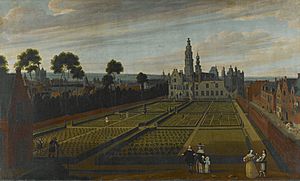
Henry III's Beliefs and Interests
Henry attended the Diet of Augsburg in 1530. At first, he was open to Martin Luther's ideas. However, he later followed Charles V's example and remained a strong Catholic.
Art and Architecture
Henry did not agree with his brother William's choice to become a Lutheran. But he continued to support him. Henry was very impressed by the Renaissance movement and its art. He saw many examples of this art during his travels to Spain and Italy.
For example, in 1536, he hired an Italian architect named Tomasso Vincidor da Bologna. Henry asked him to completely rebuild his castle at Breda in the Renaissance style. This was one of the first buildings of its kind north of the Alps. However, it seems his interest in art was not very deep. The famous scholar Desiderius Erasmus only called him a "platonic friend of science."
Henry III's Family Life and Death
Henry III was married three times during his life.
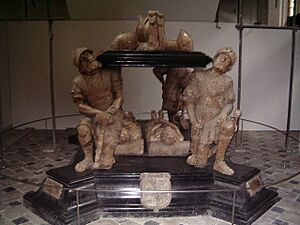
Marriages and Children
- On August 3, 1503, Henry married Françoise Louise of Savoy. They did not have any children.
- In May 1515, Henry married Claudia of Châlon. They had one son, René of Châlon, born on February 5, 1519. René became the prince of Orange in 1530 after Claudia's brother, Philibert, passed away.
- On June 26, 1524, Henry married Mencia de Mendoza y Fonseca. They had one son in March 1527, but he lived for only a few hours.
Henry did not have any other children from his marriages. However, he did have some children outside of marriage. These included Alexis of Nassau-Corroy and Isabelle of Nassau. Both were officially recognized after their father's death. They also had many descendants. One of them was Philippe François de Berghes, 1st Prince of Grimberghen.
Later Life and Legacy
Charles V strongly encouraged Henry's third marriage to Mencia de Mendoza y Fonseca. This was part of Charles's plan to bring together the noble families of Spain and the Low Countries. However, many Spaniards did not like Henry. They thought he was a loud and uncivilized German newcomer.
Henry III passed away in 1538. His only son, René, took over his titles. Sadly, René was killed in battle just a few years later in 1544. Henry is buried under the grave monument he built for his uncle Engelbert. This monument is in the Grote kerk (Great Church) in Breda.
See also
 In Spanish: Enrique III de Nassau-Breda para niños
In Spanish: Enrique III de Nassau-Breda para niños


